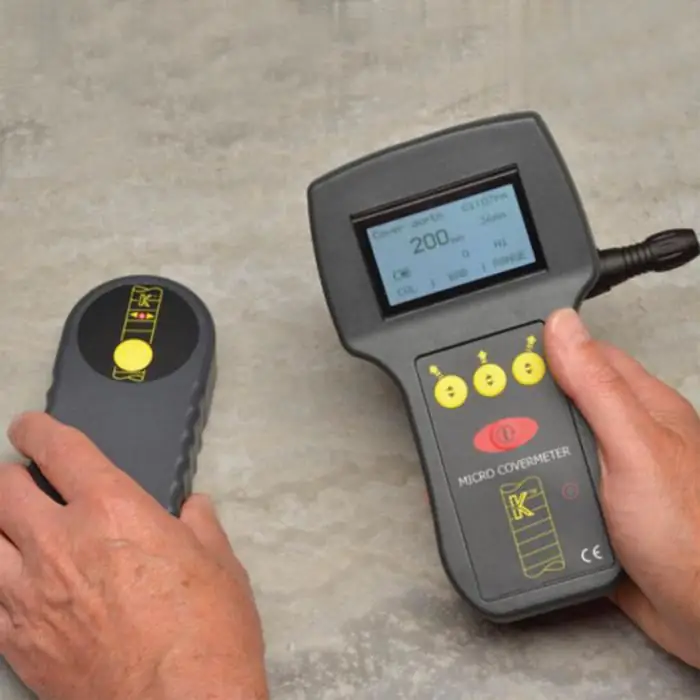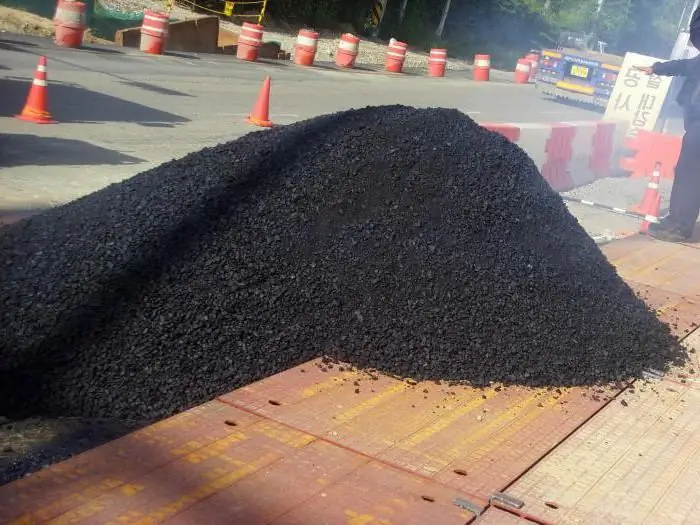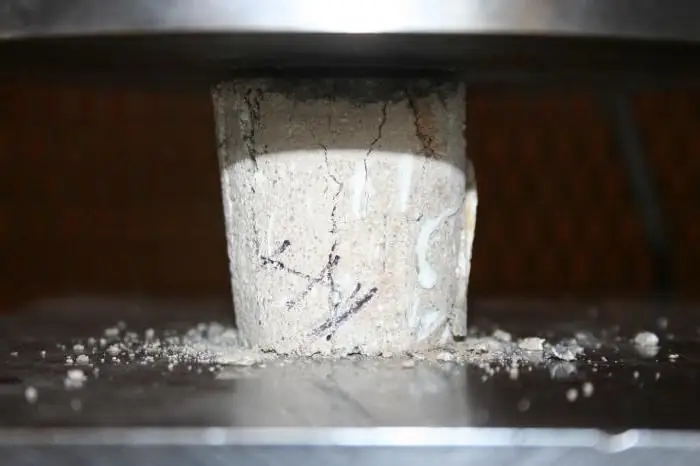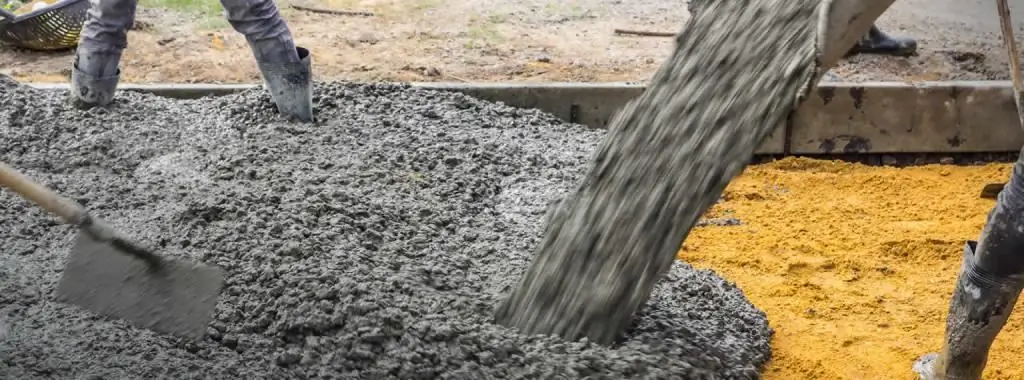2025 Author: Howard Calhoun | [email protected]. Last modified: 2025-01-24 13:10:39
Concrete M300, like any other, in principle, is an almost universal material that is currently used in many areas of construction and for a variety of purposes. Each brand of this substance has its own properties, price, characteristics, production technology.
General information
M300 is a brand that is considered almost universal, as it has an acceptable cost and fairly good properties. In addition, the parameters of the concrete mixture are predetermined by GOST. Of course, in order to obtain high-quality M300 concrete as a result, it is necessary to use good raw materials. But here it is important to note that this substance contains as many as five different components.

Components for production
Of course, the main ingredient is cement. As a rule, grades M400 and M500 are used, as they are characterized by the best properties. The use of the M200 brand is impractical, as this can worsen the parameters of the finished concrete. Due to the fact that the cement elements M200differ in weak performance, in the future it will not be able to withstand the required loads.
By the way, when buying it is very important to pay attention to the expiration date. If it has expired, then the quality of M300 concrete, like any other, will noticeably decrease.
The second element is rubble. Most often, granite, limestone or gravel is used here. It is worth noting that the granules can vary greatly in size: it can range from 5 to 70 mm. The choice of this filler is based on its strength index. It should be twice the strength that will be required from concrete. In other words, the composition of M300 concrete with limestone will be 500-600, and with gravel - 800-1000.
If you follow this rule, then in the future it will be possible to avoid the destruction of the structure. It should be added here that if the gravel is contaminated, then it will have to be washed before being added to the composition.

Also M300 concrete contains sand. This grade of material implies the presence of sand granules ranging in size from 1 to 2.5 mm. In order not to impair the performance of the future solution, the sand also needs to be sieved if it contains dirt particles.
Oddly enough, water is an essential component that affects the quality of concrete. So, if you use a chemically or biologically contaminated mixing liquid, then its properties will deteriorate. Water must be filtered before use.
The last element that has a significant impact on the characteristics of M300 concrete is additives. It is about variousplasticizers and other ingredients that are added to the material if necessary to increase its frost resistance, for example, or other technical indicators.
Characteristics of the substance
As it has already become clear, the quality of the M300 depends primarily on the components used. When applying qualitative components, the characteristics of concrete will be approximately as follows:
- Water resistant - w8. This indicator indicates that we have a composition with low permeability. Moisture absorption does not exceed 4.2% by volume.
- Frost resistance level - f200.
- Concrete of this brand belongs to the b22 class, but b25 is also often written. Depending on the requirements for future construction, the mobility class of the train can vary from p2 to p4.
- The density of M300 concrete is 1800-2500 kg/m³. This setting will vary depending on which filler was used.
- Hardness - W2-W4.
- This concrete belongs to the class of heavy.

Application
Due to the fact that M300 concrete has fairly good properties, which can also be adjusted by changing components, this composition has found wide application in construction work:
- It is used for the construction of objects such as playgrounds, roads, curbs, as it can withstand high loads and does not crumble.
- Use it to install walls or supports.
- Used in the construction of landings in apartment buildings,as well as for the stairs themselves.
- It is excellent for pouring a monolithic foundation on which a multi-storey building can stand, while not settling under pressure.
- It is used for the production of reinforced concrete products, as well as fences.
It is also worth adding that this concrete is well suited for arranging sewer pipes that are constantly exposed to high humidity, as well as being in conditions of constantly changing temperature.

DIY Components
You can buy a ready-made solution, or you can make it yourself. If you make the M300 yourself, then you need to know that it can be of two types:
- The first involves the use of cement brand M400. In this case, the ratio of such components as cement, sand, crushed stone will be as follows - 1:1, 9:3, 7.
- The second type means that you will have to use M500 cement. Here the ratio of the components will change and will look like this - 1:2, 2:3, 7.

Production
The weight of M300 concrete, or rather one of its cubes, can reach 2000 kg/m³. The recipe is quite simple, and for successful production you only need the material itself and some fixtures. So, to get one M300 cube, you will need:
- from 340 to 360 kg of cement;
- 800-850 kg of sand;
- 900-1100 kg of crushed stone;
- about 200 liters of water;
- about 10 kg of various additives (plasticizers andothers).
To produce such a quantity of material, of course, a concrete mixer will also be needed. In addition to it, a shovel is needed to load dry components, buckets for pouring water, as well as measuring containers, so that it is possible to observe the proportions of concrete M300.
Manufacturing technology is quite simple:
- The first thing to do is pour 3/4 of the total volume of water into the concrete mixer.
- After that, the equipment turns on and you can start pouring cement.
You need to mix water and cement until a homogeneous mass is formed, only then you can add crushed stone first, and then sand.

Specific gravity and dry matter producers
To successfully carry out any work in which you need to use concrete, you need to know its specific gravity, as this will help determine the required amount of initial components. For example, if you take the numbers given in the previous description and mix the solution with them, you get a cube with a specific gravity of about 2400 kg. In this case, to create concrete M300, the consumption will be about 30 bags of the mixture.
Of course, professional builders do not use this, but it will help with homework. It is also worth adding that the specific gravity includes the weight of the reinforcement, if any, as well as the place where the solution is laid.
Today, there are dry mixes, which are often called simply sand concrete. It is important to note here that it was the recipe for the preparation of M300 concrete that gave impetus to the developmentsuch a substance. It is packaged in bags with a weight of 25 to 50 kg. True, the cost for one bag will exceed the cost of the same amount of M300 by about 150 rubles. However, sand concrete is used much easier and faster. In addition, adding crushed stone to it, if necessary, is also allowed.

Hardening features
Due to its characteristics, concrete M300 is characterized by specific reactions during hardening. So, if the proportions were chosen correctly, then during this process a crystalline hydrate appears. At this time, in fact, the interaction of cement and liquid occurs, which is accompanied by the formation of a new substance. This is very important to know, because if there is too little liquid during this period of time, then the process itself will take longer, and the final strength of the concrete will decrease. In some cases, it may even shrink or crack.
If the ambient temperature is high enough, then humidification should be started no later than two hours after pouring. In a normal temperature range with sufficient air humidity, this parameter can increase up to 12 hours.
It is important to note here that it is necessary to water the concrete only with a sprayer, so as not to damage the weak surface with a jet. The nodes and edges of the structure must be watered more carefully than just a flat surface.
Recommended:
The rate of water consumption and sanitation. The principle of rationing water consumption

Economical use of all natural resources is the task of each of us. It is no secret that in cities there is a norm of water consumption for each inhabitant, such norms have been developed for industrial enterprises. Moreover, water disposal is also normalized, i.e. sewage
Concrete strength meters. Concrete testing methods

When constructing buildings and structures, it is very important to monitor the strength of concrete. For this, special devices are used. Measurement parameters can vary quite a lot
Density of asph alt concrete: material consumption and composition

The density of asph alt concrete is one of the main characteristics of this material. Asph alt concrete, as it is also called, has the form of a building artificial conglomerate, which is formed as a result of achieving the required density of the mixture laid in the structure
Determination of concrete strength: methods, equipment, GOST. Control and evaluation of concrete strength

When checking building structures, the determination of the strength of concrete is carried out to determine their state at the current time. Actual performance after the start of operation usually does not match the design parameters
Concrete mix: properties, composition, types, grades of concrete, characteristics, compliance with GOST standards and application

Among the main properties of the concrete mixture, which is also called hydrotechnical concrete, it is necessary to highlight the increased water resistance. Buildings are being built from this material to be used in swampy areas or in regions that are prone to flooding

